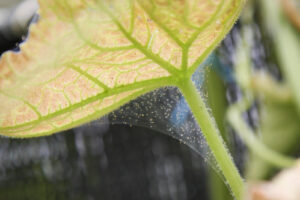
Date April 11, 2023
Anyone with a garden or backyard understands the defeating feeling of finding their trees or plants destroyed by insects. This discovery makes maintaining a beautiful outdoor area more challenging when annoying pests, such as spider mites, take over. In this post, we cover everything property owners need to know about spider mites.
What Are Spider Mites?
Image via Flickr by blumenbiene
Spider mites are tiny members of the arachnid family, measuring 1/50th of an inch long. They are reddish-brown or pale in color and have a sac-like, oval-shaped body. Despite their minuscule size, they thrive in colonies of hundreds of mites, easily covering large areas of plants. These pests use their mouths to suck nutrients from plant cells, causing significant damage to shrubs and trees because of their large colonies.
Signs of Spider Mite Infestation
Spider mites rely on the wind to disperse their population to different landscape areas. They love gardens full of flowering plants, fruits, and vegetables but also thrive on conifer trees like spruce and pine or deciduous trees such as oak and elms.
Spider mites reproduce all year, feeding and laying eggs in the warm spring and living off plants that stay green in the winter. However, their colonies become more noticeable from June to September. These critical signs can mean spider mites are inhabiting the trees:
- Tight webbing. Web-spinning spider mites build their colonies by creating webs that connect the needles and foliage of conifers or wrap around leaves and blossoms of deciduous trees.
- Stippling. Inspect tree leaves for fine dots, indicating the feeding markings of spider mites. Over time, the leaves will begin to turn yellow.
- Premature leaf drop. Large spider mite infestations cause visible damage, including dried-up leaves falling from the trees during an unseasonal time of year.
- Sunburned leaves. Spider mites take advantage of water-stressed plants and rob their leaves of necessary nutrients for survival, making them more prone to sun damage.
Spider mites are rarely easy to notice in their early life cycle stages because they haven’t yet inflicted notable damage on the trees. A trick to detect spider mites is to shake suspected leaves over a sheet of white paper. The spider mites will appear as little dots crawling across the paper. Once you detect them, the next crucial step is to seek help to rid the trees of these pests.
Prevention and Protection
Spider mites are common in hot and dry conditions, much like the Dallas-Fort Worth, Texas, area. That’s why our TreeNewal insect management team is well-qualified to remove these pests. Once we assess a property’s trees, we will formulate a tree care plan to return them to good health. Depending on the severity of the spider mite infestation, we will trim or prune the tree, apply pesticides, and ensure the garden has adequate water and nourishment with our special fertilizer blend.
Knowing the signs of a spider mite infestation can greatly reduce the damage it can cause. Spider mites are just one of many pests and insects that destroy trees, so it is important for homeowners to monitor trees regularly. If you have any questions or concerns, call us at 817-500-9325, and our ISA Certified Arborists will help bring your trees back to life.









